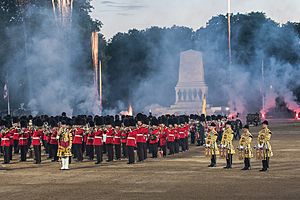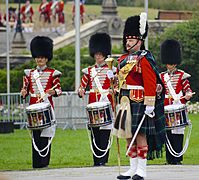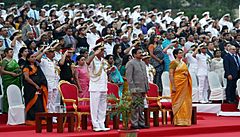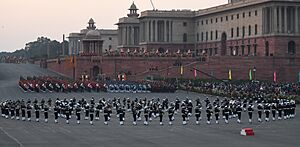Beating retreat facts for kids
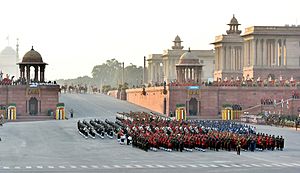
Beating Retreat is a special military ceremony that started in England way back in the 1600s. It was first used to call soldiers who were patrolling nearby back to their castle at the end of the day.
Contents
History of the Ceremony
This ceremony was originally called watch setting. It began at sunset with a single shot from the evening gun.
In 1690, an order from the army of James II of England (also known as James VII of Scotland) told drummers to beat a signal for troops to retreat. Later, in 1694, William III issued another order. It said that the main drummers of a regiment should beat the Retreat through the streets. Other drummers from different groups would answer them. These early orders might also be talking about a similar ceremony called a tattoo.
For the first time ever in England, a band from another country was allowed to play at the Beating Retreat. This happened on June 5, 2008. The band was from the Royal Malay Regiment, who had been helping to guard London. They played music from movies.
This happened again in June 2014, when two bands from the French Armed Forces took part. This event honored 70 years since D-Day. In June 2015, the ceremony honored 200 years since the Battle of Waterloo. The Staff Band of the Bundeswehr from Germany joined in.
Beating Retreat in the United Kingdom
The Household Division's Ceremony
Today, many armed forces in the Commonwealth perform a ceremonial Beating Retreat. It's often used to test new band members and practice difficult marching moves. These ceremonies usually involve a marching band, cannons firing, and other special displays. Sometimes, a castle is used as a backdrop for the parade.
The London version of the ceremony takes place at Horse Guards Parade. Each year, before the Trooping the Colour event, the Massed Bands, Pipes and Drums, and Corps of Drums of the Household Division perform. They are joined by The King's Troop Royal Horse Artillery and military bands from other countries. This sunset concert includes precise marching, horses, cannons, and fireworks set to music. A senior member of the British Royal Family often attends and watches the parade.
This concert helps raise money for the Army Benevolent Fund and Household Division charities. These funds help soldiers and veterans of the Household Division.
Royal Marines' Ceremony
The Massed Bands of His Majesty's Royal Marines have about 200 musicians. They perform their Beating Retreat ceremony every two years at London's Horse Guards Parade. This celebrates the birthday of their Captain General, Charles III (as of 2022). Because it's so popular, it usually happens over three nights.
Recent events included June 2012, honoring the Diamond Jubilee of Elizabeth II. In June 2014, it honored the Royal Marines' 350 years of service. Bands from the United States Marine Corps and the Netherlands Marine Corps also joined. In June 2016, it marked Elizabeth II's 90th birthday and was streamed live on Facebook. An event in May 2018 marked the Sapphire Jubilee of Elizabeth II. Another event in 2022 marked two important moments: the Platinum Jubilee of Elizabeth II and 40 years since the Falklands War.
The salute is usually taken by the Captain General, the First Sea Lord, or the Commandant General. Sometimes, a senior royal family member like Prince William or other important guests take the salute.
The Royal Marines' ceremony is different from the Army's, which happens every year. Four to five bands from the Royal Marines Band Service make up the massed bands for this ceremony.
The Rifles' Ceremony
Sounding Retreat is a special version of the ceremony performed by the Band of The Rifles. It was also done by the bands of the Light Division in the past. This is because bugles are used in this ceremony to play "Sunset" (which is called "Retreat" in the Army). This tradition comes from the history of British light infantry soldiers.
On May 31 and June 1, 2016, the Bands of the Rifles and the Brigade of Gurkhas performed the first "Sounding Retreat" on Horse Guards Parade since 1993.
Beating Retreat in Australia
The Australian Defence Force has a traditional Beating Retreat ceremony, passed down from the British Army. The first ceremony, which included Tchaikovsky's "1812 Overture", was held at the Royal Military College, Duntroon in 1968. This event has become an annual tradition.
The modern ceremony combines three old customs:
- First Custom: Drummers would march to warn soldiers that evening guard duties were starting. It also told soldiers outside the walls to come back inside before the gates closed for the night.
- Second Custom: On old battlefields, fighting stopped at sunset. After the Beating Retreat, many regiments would pray or sing for their fallen comrades. The evening guard would fire three musket shots to scare away "evil spirits."
- Third Custom: This comes from the practice of putting the Regimental Colour (a special flag) in the Colour Ensign's room when the evening guard began. Today, this is replaced by lowering the national flag.
2007 Ceremony in Australia
The 2007 ceremony took place on September 27 and 28. Important military leaders, like Chief of the Defence Force ACM Angus Houston, attended.
The ceremony included marching, changing of guards, inspecting the guards, firing the evening gun, and lowering the Australian flag. Music was played by the Royal Military College Band and the Australian Army Band Tasmania. They played songs like "All That Jazz," "Spider-Man Theme," and "Candyman."
The ceremony ended with the "1812 Overture," played with 105 mm Hamel light field guns, and a 5-minute fireworks show.
Beating Retreat in Canada
The annual Fortissimo Sunset Ceremony of the Canadian Forces is Canada's version of the Beating Retreat. It usually happens on a July evening at Parliament Hill in Ottawa. The Ceremonial Guard and its combined bands organize it. This ceremony is special because it combines Beating Retreat with military tattoos and the lowering of the Canadian flag. It is the main event of a festival. In the past, drill teams from other countries have also joined, like the German Navy Silent Drill Team.
Beating Retreat in India
Background and History in India
Beating Retreat in India officially marks the end of the Republic Day celebrations. It happens on the evening of January 29, three days after Republic Day. The Ministry of Defence organizes it. Bands from the Indian Army, Indian Navy, and Indian Air Force perform. Pipe bands from the Army also join. Since 2016, bands from the Central Armed Police Forces and the Delhi Police have also taken part. The ceremony takes place at Raisina Hills and Vijay Chowk, near the Rashtrapati Bhavan (President's Palace).
The ceremony started in 1955 and has been a key part of Republic Day celebrations ever since. It was first thought up by Brig Bewoor and Maj Roberts of the Indian Army. It has become an official ceremony where a country's Head of State is the chief guest.
Order of Ceremony in India
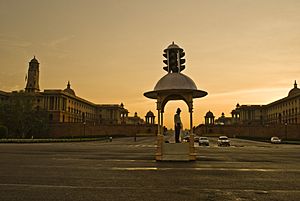
The main guest is the President of India, who arrives with the President's Bodyguard (PBG). When the President arrives, trumpeters play a special tune. Then, the PBG commander asks for the national salute. This is followed by the massed bands playing the Indian national anthem, Jana Gana Mana. At the same time, the flag of India is raised.
The ceremony begins with the massed bands of the three services marching together. They play popular marching tunes like Colonel Bogey March, Sons of the Brave, and Qadam Qadam Badhaye Ja. After the trumpeters play, the Navy and Air Force bands perform. This part ends with their complex marches, forming beautiful patterns. Then, the Indian Army's pipes and drums play traditional Scottish and Indian tunes like Gurkha Brigade and Chaandni. The pipe bands also do special marches. Finally, the Indian Army's massed military bands perform.
In 2016, marching bands from the Central Armed Police Forces and the Delhi Police also appeared for the first time. The Army Symphony Orchestra and Traditional Ensemble also performed. The Traditional Ensemble uses a mix of European and Indian instruments. The police forces' appearance showed their important role, just like the armed forces.
All the band groups march forward close to the President. Drummers, mostly from the Army's pipe bands, perform a solo called the Drummer's Call. A regular part of this event is the last tune played before the Retreat, when the national flag is lowered. This is the famous hymn Abide With Me. It was one of Mahatma Gandhi's favorite hymns. The sound of tubular bells creates a magical atmosphere.
After this, buglers play the bugle call for sunset, and all the flags are slowly lowered. The band master then asks the President for permission to take the bands away, saying the ceremony is complete. The bands march back playing a popular military tune and the official march of the Armed Forces, Sare Jahan se Accha. As the bands leave, a spectacular light and sound show begins on the North and South Blocks of the Parliament building. As the President's Bodyguard (PBG) horse-mounted troops return, another Army band plays the national anthem again. The President receives the final salute from the PBG before leaving.
Beating Retreat in Pakistan
The Wagah border closing ceremony, also called 'lowering of the flags,' is a daily military practice. The security forces of India (Border Security Force) and Pakistan (Pakistan Rangers) have done this together since 1959.
Beating Retreat in Jordan
The Beating Retreat of the massed pipe and brass bands of the Royal Jordanian Army takes place in Amman, the capital city. The King and Queen of Jordan usually attend, along with other important members of the royal family, government, and military. The ceremony is held during celebrations for Independence Day, Army Day, and the Great Arab Revolt (in May, June, and September). This ceremony has happened every year since the early 1950s. It was started by King Hussein of Jordan.
Beating Retreat in New Zealand
The New Zealand Defence Force usually performs a Beating Retreat ceremony every year around Anzac Day. Most ceremonies feature musicians from the New Zealand Army Band and troops from the New Zealand Army and the Royal New Zealand Air Force. They form a guard of honour for the special guest, usually the Governor-General of New Zealand or the Mayor of Wellington.
Beating Retreat in the United States
The "Ceremony of Beating Retreat" happens every year at the United States Merchant Marine Academy. It usually includes the USMMA Band and selected students. This ceremony takes place during a parent weekend so families can attend. Also, at The Citadel, there is a weekly tradition of retreat parades. These parades combine drill moves and a performance by The Regimental Band and Pipes. Their purpose is to inspect the students, honor traditions, and build unity.
The United States Marine Corps Friday Evening Parade and Sunset Parade are similar to the Household Division Beating Retreat. Both are military tattoos performed by troops from Marine Barracks, Washington, D.C..
See also
- Republic Day of India
- Delhi Republic Day parade
- Trooping the Colour
- Changing the Guard
- Großer Zapfenstreich
- Ceremony of the Flags
List of Foot Guards Bands:
- Coldstream Guards Band
- Grenadier Guards Band
- Irish Guards Band
- Scots Guards Band
- Welsh Guards Band
|


